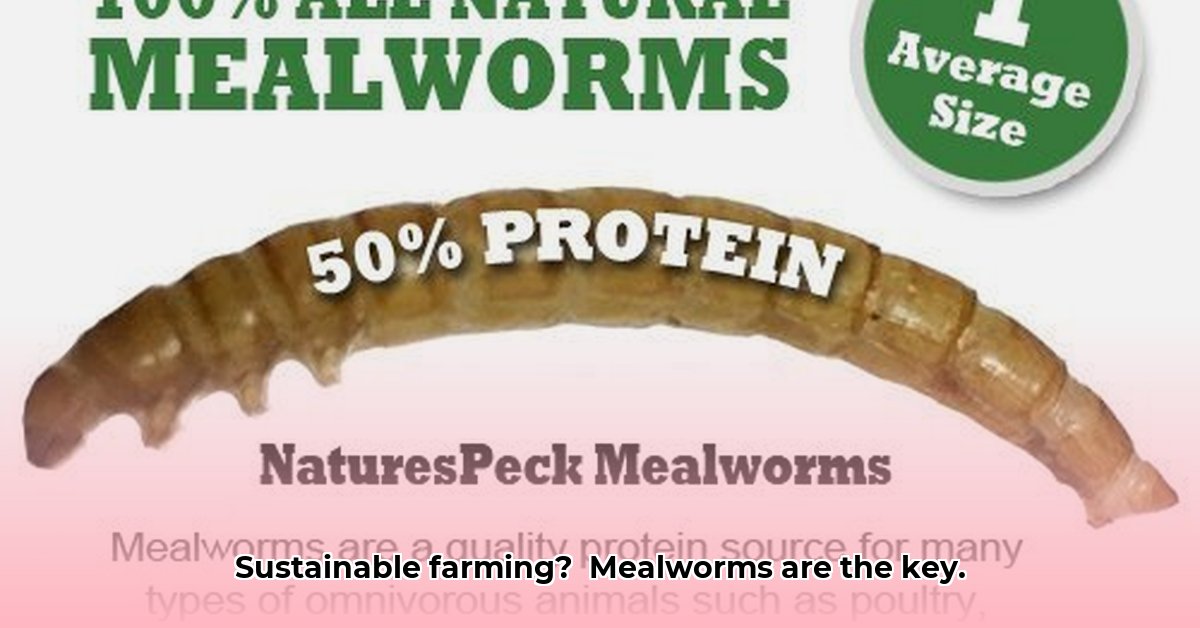
Exploring the Potential of Mealworms in Sustainable Agriculture
The increasing availability of mealworms, readily accessible even at retailers like Tractor Supply, signifies a burgeoning interest in sustainable agricultural practices. Mealworms, with their high protein content and efficient production methods, are emerging as a compelling alternative to traditional animal feeds like soy and corn. But how effective are they, and what are the practical considerations for farmers looking to integrate them into their operations? This article delves into the nutritional benefits, environmental impact, and economic viability of mealworm farming, providing a practical guide for farmers and a glimpse into the future of insect-based agriculture. For chick-raising supplies, check out Tractor Supply chick prices.
The Nutritional Powerhouse: Mealworm Benefits for Livestock
Mealworms are nutritionally dense, boasting a high protein content (approximately 50-60%) along with essential amino acids and healthy fats. This rich nutrient profile makes them an attractive alternative to conventional feed sources. Studies suggest that incorporating mealworms into animal diets can enhance animal health, boosting immune function and potentially increasing productivity (e.g., egg laying in chickens). However, it's crucial to remember that a balanced diet is multifaceted. Thorough nutritional analysis is essential to ensure mealworms provide a complete complement to other feed components, preventing deficiencies. "A balanced approach, including a careful assessment of nutrient bioavailability, is crucial," notes Dr. Anya Sharma, Professor of Animal Nutrition, University of California, Davis.
Environmental Considerations: A Sustainable Feed Source?
Insect farming, including mealworm production, generally exhibits a lower environmental footprint compared to traditional livestock agriculture. Mealworms require significantly less land and water, minimizing habitat destruction and water consumption. Furthermore, their ability to consume organic waste – such as agricultural byproducts – positions them as a key component of a circular economy, reducing waste streams and maximizing resource utilization. However, the overall environmental impact is contingent on factors like production scale, substrate sourcing, and waste management practices. Large-scale mealworm farming requires robust, sustainable methods to ensure these environmental benefits are maximized. Further comprehensive research is needed to fully quantify the long-term ecological effects.
A Practical Guide: Integrating Mealworms into Your Farming Operations
Adopting mealworms as a feed source requires planning and a phased approach. Follow these steps to seamlessly integrate mealworms into your farming practices:
Assess Nutritional Needs: Carefully determine your animals' dietary requirements and calculate the necessary mealworm supplementation to ensure optimal nutrition. Consult with an animal nutritionist for personalized recommendations considering your specific livestock and feed goals.
Select a Reliable Supplier: Choose a reputable supplier offering high-quality mealworms. While Tractor Supply offers convenience, compare prices and quality from various suppliers to identify the most cost-effective and sustainable option for your operation's scale.
Gradual Introduction: Avoid abrupt dietary changes. Introduce mealworms gradually, mixing them with existing feed to allow animals to adapt. Monitor their health closely during this transition for early signs of any adverse reactions.
Meticulous Record-Keeping: Maintain detailed records of animal growth rates, health indicators, and productivity metrics (e.g., egg production, meat yield). This data will be invaluable for evaluating the efficacy of mealworm supplementation and identifying areas for optimization.
Sustainability Evaluation: Continuously assess the environmental impact of your mealworm use. Compare it to your traditional methods and identify opportunities for enhancing sustainability, such as waste reduction or the use of locally sourced substrates.
The Economic Landscape: Comparing Mealworm and Traditional Feed Costs
The economic viability of using mealworms hinges on several factors, making a direct comparison with traditional feed complex. Large-scale operations might benefit from economies of scale, lowering per-unit costs. However, substrate choice is a key expense. Small-scale operations can leverage low-cost substrates like compost, while larger facilities often rely on bulk purchases of wheat bran or similar, impacting overall cost-benefit analysis. Local market prices for both mealworms and traditional feeds introduce regional variations in profitability. "Profitability in mealworm farming is highly context-dependent," explains Dr. Ben Carter, Agricultural Economist, Purdue University. "Factors such as scale, substrate costs, and market dynamics must be carefully considered."
To accurately compare costs:
Define your feed needs: Determine the total feed required, based on the size and needs of your animal population.
Research substrate costs: Investigate the price of various substrates and consider the availability of cheaper alternatives.
Estimate mealworm production costs: Account for substrate, labor, and potential losses.
Calculate traditional feed costs: Estimate the cost of traditional feeds to achieve similar nutritional value.
Compare total costs: Consider both direct and indirect costs.
Evaluate nutritional equivalence: Ensure the mealworm nutrition meets your animals' needs.
The Future of Mealworms in Sustainable Agriculture
The market for insect-based feeds is poised for significant growth, driven by rising awareness of sustainability concerns and demand for alternative protein sources. However, challenges remain. Scaling production while maintaining consistent quality and supply remains critical. Furthermore, establishing clear regulatory frameworks and fostering consumer acceptance are essential for wider adoption. The success of insect-based feeds relies on collaborative efforts from researchers, farmers, processors, and consumers to address these challenges and unlock the full potential of this innovative, sustainable approach to animal feed. Tractor Supply's involvement marks a significant step toward making this transition more accessible.